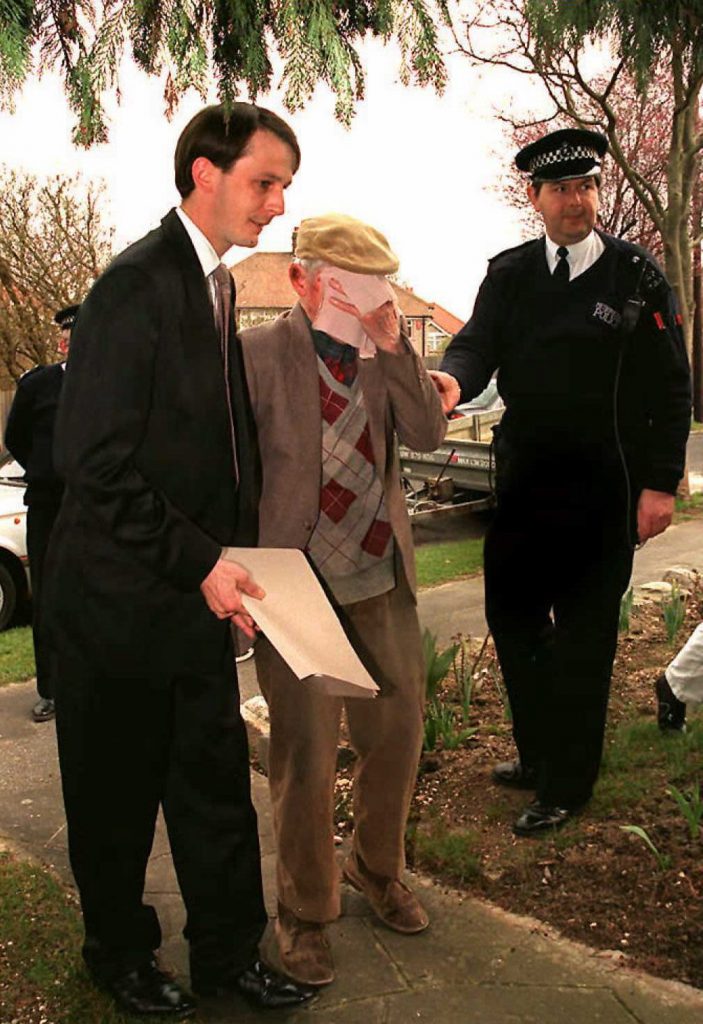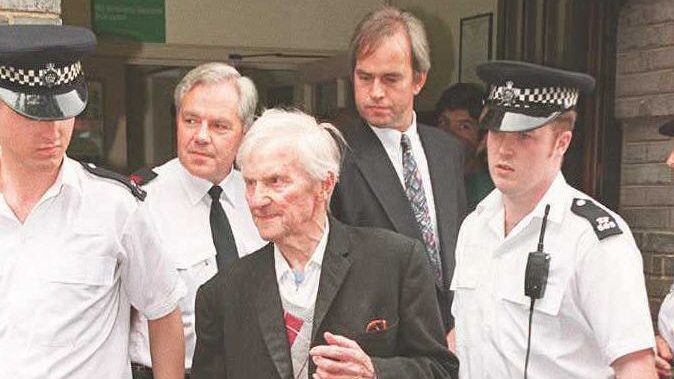Allegations of “war crimes”, “breaches of international law” and “crimes against humanity” are being heard daily as the world watches in despair at the Hamas atrocities in southern Israel and the appalling death toll in Gaza. But, as an important new book – Safe Haven: the United Kingdom’s Investigations into Nazi Collaborators and the Failure of Justice by Jon Silverman and Robert Sherwood – makes clear, such charges are easily made but not so easily successfully prosecuted.
Politicians – mainly on the right – today obsess about the number of would-be refugees seeking asylum in Britain; but compared with the mass movement of people in Europe in the aftermath of the second world war, the current numbers barely represent a trickle. Many of those seeking sanctuary in Britain at the time were the victims (mainly but not exclusively Jewish) of the horrendous crimes of the Nazis, but some – a number reckoned to be in the thousands – were the very perpetrators of, or collaborators in, those crimes.
Postwar entry into Britain for those suspected of involvement with the Nazi war crimes was far from testing, as Silverman and Sherwood recount. The interviews were “cursory and superficial”, mainly conducted by immigration officers with little or no detailed knowledge of what had happened during the war.
The failure to use experienced police officers or members of the security service from the outset represents the beginnings of a tale of missed opportunities, bureaucratic bungling and arcane legalistic disputes that resulted in Britain’s shameful tally. We successfully prosecuted just one Nazi war criminal, while many hundreds, perhaps even thousands, of perpetrators gained admittance to the UK after the war and were able to settle here, live comfortably and die peacefully in their beds, without ever having to face any court of law for the crimes they had committed.
In the immediate aftermath of the war there were investigations by the British military in occupied Germany, resulting in some successful prosecutions of war criminals. But public awareness of the truly brutal nature of the Holocaust and other Nazi war crimes only began to grow much later, in the 1980s. There was also an increasing sense of unease that, compared with many of our European counterparts, Britain had done so very little to bring perpetrators of Nazi war crimes to justice.
The result was the 1991 War Crimes Act, which empowered British law enforcement agencies, and specifically Scotland Yard, to establish a War Crimes Investigation Unit to pursue Nazi war criminals living in Britain.
But, in what can only be described as a monumental failure of official will, despite 274 suspects being investigated, and the submission of more than 250,000 pages of evidence, there was only a single conviction. The explanation is simple: the investigation took place with one hand, arguably both hands, tied behind the backs of the investigators.
As the authors forensically reveal, the Crown Prosecution Service laid down extremely strict conditions that had to be met before they could undertake any prosecutions. These included the insistence that a suspect had to have been in a command position (a criterion nowhere to be found in the War Crimes Act), that the victims had to have been Jews (notwithstanding the many thousands of non-Jews murdered) and that there had to be “credible eyewitnesses” (despite the amount of time that had passed) prepared to testify in open court that they had seen the defendant kill. Even the most compelling cases failed to pass the threshold.
Britain’s record in this matter can only be described as shameful, though the authors are far too circumspect to endorse any suggestion that this failure was deliberate – they use the word “meagre” to describe Britain’s record. After describing how one perpetrator escaped justice, because not all the above criteria had been met, the authors wryly note: “Once again historical ‘truth’ and the requirements of law had to part company”.
This might all sound a tad dry and legalistic, but this book certainly isn’t. It recounts story after story of how men who can only be described as monsters evaded justice throughout the rest of their lives, ending their days unencumbered by responsibility for the dreadful atrocities they had committed half a century earlier.

Take the case of Szymon Serafinowicz, who until the War Crimes Unit caught up with him was living comfortably in the Surrey commuter town of Banstead. Investigations by the Soviet secret police 50 years earlier had revealed that Serafinowicz had been a commander of a Nazi-supporting auxiliary police unit in Belarus, and had been personally responsible for more than 4,000 victims being tortured or burned to death.
He had originally been questioned by military police immediately after the war and sent to Britain for further investigation, but was released following interrogation by the man in charge of the postwar investigations, Col Alexander Paterson, who wrote: “Serafinowicz makes a good impression, he is a pleasant and easygoing type, has a somewhat sly character, possessing a slightly shifty eye, but could not be described as anything approaching a brutal type.”
In 1997 Serafinowicz was re-arrested, but again never had to stand trial, this time on account of his Alzheimer’s rather than his “easygoing” manner – although with a sense of poetic justice, the authors note that “… he died clutching a newspaper open at a page that carried the headline: ‘First man to be charged with Nazi war crimes arrested in Surrey’.”
The only war criminal to actually be charged and convicted in postwar Britain was Anthony (Andrzej) Sawoniuk, another auxiliary policeman from Belarus. He was found guilty in 1999 of the murder of 18 Jews, which, as the authors make clear, made him a relatively insignificant war criminal compared with some of the monsters who escaped British justice. Sawoniuk received a life sentence and died in prison six years later.
Silverman’s interest in the topic dated back to his time as the BBC’s correspondent in Paris. “The first major story I covered was the 1987 trial of Klaus Barbie, the wartime Gestapo chief, in Lyons, known as ‘the Butcher of Lyons’,” he told me. “I spoke to a lot of ex-resistance fighters about their experience of the Nazi occupation.”
But what struck Silverman in particular was how the French used the trial to educate the young about the past. “Schoolchildren were bussed in every day to watch the proceedings, so it was a trial conceived as an educative process.” And, he adds: “While writing the book, the Barbie trial was in my mind as a complete contrast to the UK common law conception of criminal justice, which treated charges of Nazi war crimes as just ‘normal’ murder cases, virtually ignoring the horrific wider context of the Holocaust.”
It was his experience as an investigative journalist that, he claims, led to the breakthrough that gave an impetus to the writing of the book: “Undoubtedly, the biggest ‘boost’ was being offered a huge cache of documents by the solicitor who represented the first person to be prosecuted, Szymon Serafinowicz, after the case had collapsed. This material included police interviews with suspects, NKVD interrogations of witnesses from the 1940s, Home Office and M15 letters about suspects etc. It was a treasure trove! But it sat in an archive at Southampton University, unnoticed for years.”
Sherwood’s route to investigating the failures of Britain to prosecute Nazi war criminals was very different. After 30 years as a senior detective in the Metropolitan Police, his interest in studying the war crimes fiasco was piqued by initially gaining a law degree and then an MA in Holocaust Studies.
But he is reluctant to ascribe any malign motives to Britain’s very poor record in prosecuting Nazi war criminals. Instead, he explains: “I don’t believe that these unique crimes were fully appreciated, or understood, by either the immediate postwar team or the War Crimes Investigations Unit” – although he does admit to being “slightly disappointed in the ultimate outcome”.
One reason for the failure, he suggests, was the decision taken by the 1991 unit not to allow anyone of Jewish descent to be part of the investigations team, on the basis that this might compromise their “objectivity”. “Such an input would have been invaluable,” he says. “The team would have been able to add a knowledge of Jewish culture to their work. After all, it had been decided the inquiry team would only focus on Jewish victims.” He believes another failing was not ensuring that the team had some knowledge of the Holocaust, so that they would have been able to speak to survivors with more understanding.
Despite the fact that the book is about events that happened 80 years ago, and about investigations that took place almost 30 years ago, Silverman believes the issues raised are still highly relevant. “Legal accountability for war crimes is very much in vogue now,” he says, and not only because of the war in Gaza.
“Putin, for example, has been indicted by the International Criminal Court – any such prosecution, however unlikely, would be based on the principle of ‘universal jurisdiction’.” This means, he explains, “the principle where a country with a functioning justice system has the right to try a citizen of another state for crimes such as murder, torture, rape and abduction etc, if it is able to arrest that citizen/suspect.”
It has been successfully used in countries such as Spain, France and Germany where trials of people indicted for war crimes in such diverse places as Syria, Iraq, and South America have been held. But the UK has shown great reluctance to use ‘universal jurisdiction’. “This is another example of British particularism, which distinguished its approach to prosecuting Nazi collaborators, thus leading to the ‘failure of justice’ in the book’s title.”
Obviously, it is now far too late to do anything about prosecuting Nazi war criminals; but it is not too late to ensure that in the future, those suspected of committing war crimes, or crimes against humanity, were they found to be in Britain, should be swiftly brought to justice in a way that so many Nazi war criminals, to our eternal shame, never were.
Safe Haven: The United Kingdom’s Investigations into Nazi Collaborators and the Failure of Justice by Jon Silverman and Robert Sherwood, Oxford University Press, £30. Ivor Gaber is professor of political journalism at the University of Sussex



